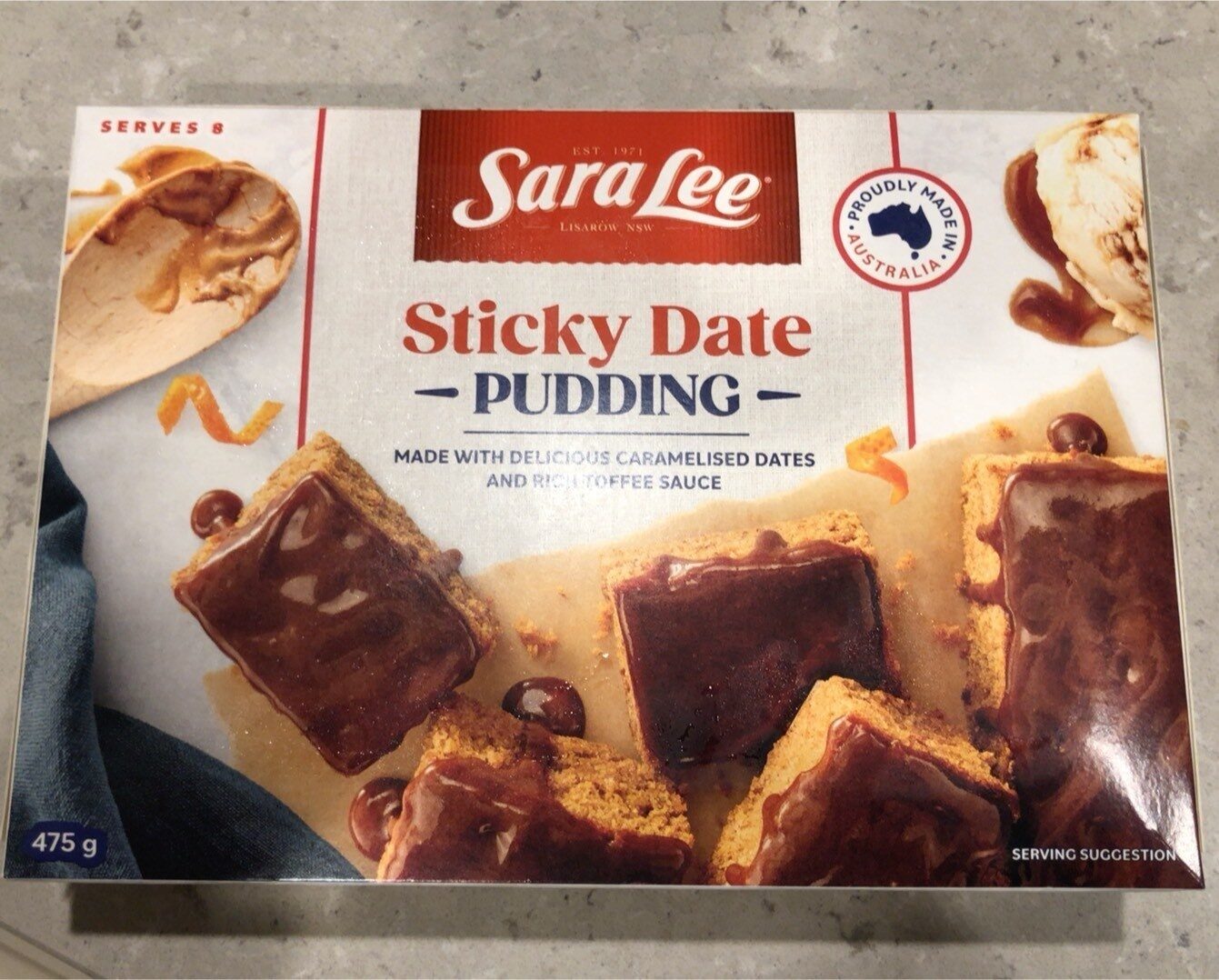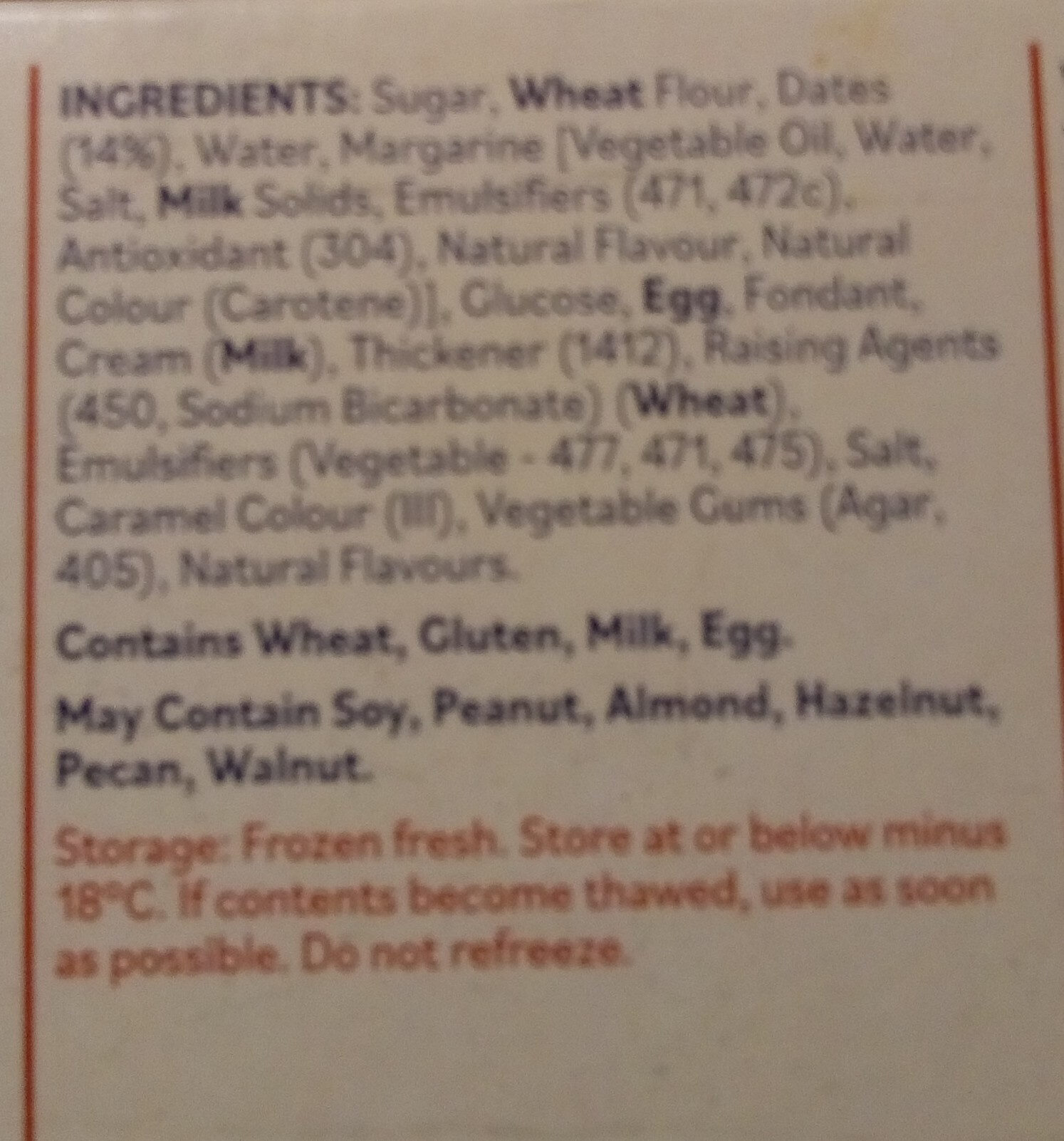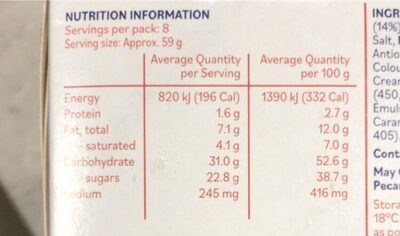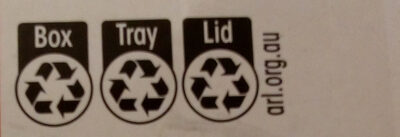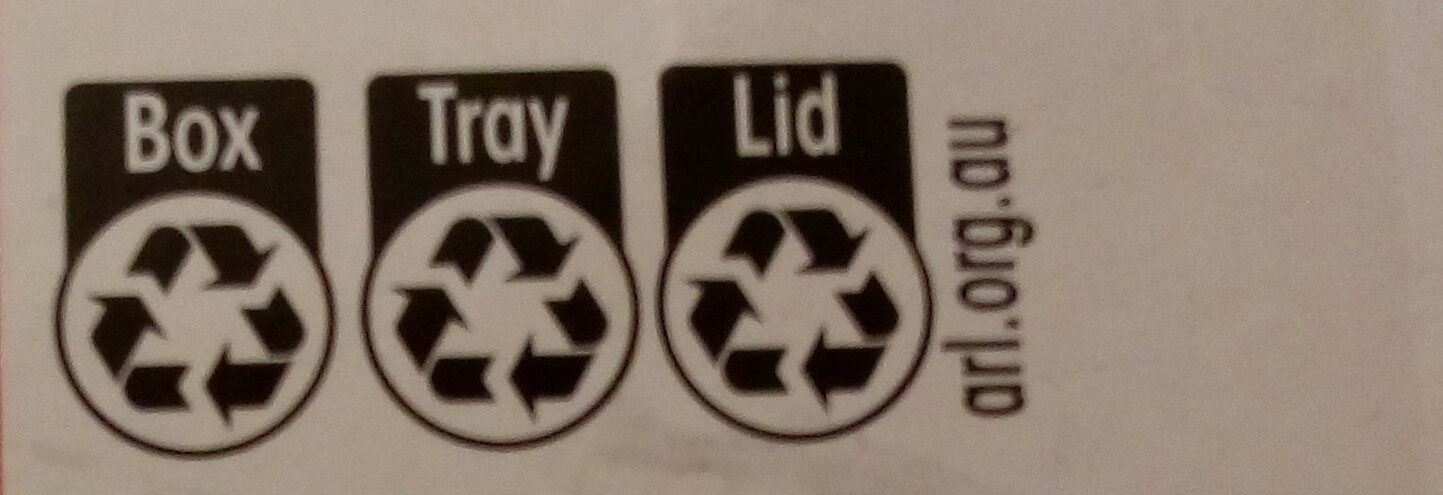Help us make food transparency the norm!
As a non-profit organization, we depend on your donations to continue informing consumers around the world about what they eat.
The food revolution starts with you!
Sticky Date Pudding - Sara Lee - 475g
Sticky Date Pudding - Sara Lee - 475g
Barcode: 9310135026570 (EAN / EAN-13)
Quantity: 475g
Packaging: Paper, Aluminum foil
Brands: Sara Lee
Categories: Snacks, Desserts, Sweet snacks, Frozen foods, Biscuits and cakes, Frozen desserts, Cakes
Origin of ingredients: Australia
Countries where sold: Australia
Matching with your preferences
Health
Ingredients
-
44 ingredients
Sugar, Wheat Flour, Dates (14%), Water, Margarine [Vegetable Oil, Water, Salt, Milk Solids, Emulsifiers (471, 472c). Antioxidant (304), Natural Flavour, Natural Colour (Carotene)], Glucose, Egg, Fondant, Cream (Milk), Thickener (1412), Raising Agents (450, Sodium Bicarbonate) (Wheat), Emulsifiers (Vegetable-477, 471, 475), Salt, Caramel Colour (I), Vegetable Gums (Agar, 405), Natural Flavours. Contains Wheat, Gluten, Milk, Egg. May Contain Soy, Peanut, Almond, Hazelnut, Pecan, Walnut. Storage: Frozen fresh. Store at or below minus 18°C. If contents become thawed, use as soon as possible. Do not refreeze.Allergens: Eggs, Gluten, MilkTraces: Nuts, Peanuts, Soybeans
Food processing
-
Ultra processed foods
Elements that indicate the product is in the 4 - Ultra processed food and drink products group:
- Additive: E1412 - Distarch phosphate
- Additive: E150c - Ammonia caramel
- Additive: E160a - Carotene
- Additive: E405 - Propane-1‚2-diol alginate
- Additive: E406 - Agar
- Additive: E450 - Diphosphates
- Additive: E471 - Mono- and diglycerides of fatty acids
- Additive: E472c - Citric acid esters of mono- and diglycerides of fatty acids
- Additive: E475 - Polyglycerol esters of fatty acids
- Additive: E477 - Propane-1‚2-diol esters of fatty acids
- Ingredient: Colour
- Ingredient: Emulsifier
- Ingredient: Flavouring
- Ingredient: Glucose
- Ingredient: Thickener
Food products are classified into 4 groups according to their degree of processing:
- Unprocessed or minimally processed foods
- Processed culinary ingredients
- Processed foods
- Ultra processed foods
The determination of the group is based on the category of the product and on the ingredients it contains.
Additives
-
E160a - Carotene
Carotene: The term carotene -also carotin, from the Latin carota, "carrot"- is used for many related unsaturated hydrocarbon substances having the formula C40Hx, which are synthesized by plants but in general cannot be made by animals -with the exception of some aphids and spider mites which acquired the synthesizing genes from fungi-. Carotenes are photosynthetic pigments important for photosynthesis. Carotenes contain no oxygen atoms. They absorb ultraviolet, violet, and blue light and scatter orange or red light, and -in low concentrations- yellow light. Carotenes are responsible for the orange colour of the carrot, for which this class of chemicals is named, and for the colours of many other fruits, vegetables and fungi -for example, sweet potatoes, chanterelle and orange cantaloupe melon-. Carotenes are also responsible for the orange -but not all of the yellow- colours in dry foliage. They also -in lower concentrations- impart the yellow coloration to milk-fat and butter. Omnivorous animal species which are relatively poor converters of coloured dietary carotenoids to colourless retinoids have yellowed-coloured body fat, as a result of the carotenoid retention from the vegetable portion of their diet. The typical yellow-coloured fat of humans and chickens is a result of fat storage of carotenes from their diets. Carotenes contribute to photosynthesis by transmitting the light energy they absorb to chlorophyll. They also protect plant tissues by helping to absorb the energy from singlet oxygen, an excited form of the oxygen molecule O2 which is formed during photosynthesis. β-Carotene is composed of two retinyl groups, and is broken down in the mucosa of the human small intestine by β-carotene 15‚15'-monooxygenase to retinal, a form of vitamin A. β-Carotene can be stored in the liver and body fat and converted to retinal as needed, thus making it a form of vitamin A for humans and some other mammals. The carotenes α-carotene and γ-carotene, due to their single retinyl group -β-ionone ring-, also have some vitamin A activity -though less than β-carotene-, as does the xanthophyll carotenoid β-cryptoxanthin. All other carotenoids, including lycopene, have no beta-ring and thus no vitamin A activity -although they may have antioxidant activity and thus biological activity in other ways-. Animal species differ greatly in their ability to convert retinyl -beta-ionone- containing carotenoids to retinals. Carnivores in general are poor converters of dietary ionone-containing carotenoids. Pure carnivores such as ferrets lack β-carotene 15‚15'-monooxygenase and cannot convert any carotenoids to retinals at all -resulting in carotenes not being a form of vitamin A for this species-; while cats can convert a trace of β-carotene to retinol, although the amount is totally insufficient for meeting their daily retinol needs.Source: Wikipedia
-
E304 - Fatty acid esters of ascorbic acid
Ascorbyl palmitate: Ascorbyl palmitate is an ester formed from ascorbic acid and palmitic acid creating a fat-soluble form of vitamin C. In addition to its use as a source of vitamin C, it is also used as an antioxidant food additive -E number E304-. It is approved for use as a food additive in the EU, the U.S., Canada, Australia, and New Zealand.Ascorbyl palmitate is known to be broken down -through the digestive process- into ascorbic acid and palmitic acid -a saturated fatty acid- before being absorbed into the bloodstream. Ascorbyl palmitate is also marketed as "vitamin C ester".Source: Wikipedia
-
E405 - Propane-1‚2-diol alginate
Propylene glycol alginate: Propylene glycol alginate -PGA- is an emulsifier, stabilizer, and thickener used in food products. It is a food additive with E number E405. Chemically, propylene glycol alginate is an ester of alginic acid, which is derived from kelp. Some of the carboxyl groups are esterified with propylene glycol, some are neutralized with an appropriate alkali, and some remain free.Source: Wikipedia
-
E406 - Agar
Agar: Agar -pronounced , sometimes - or agar-agar is a jelly-like substance, obtained from red algae.Agar is a mixture of two components: the linear polysaccharide agarose, and a heterogeneous mixture of smaller molecules called agaropectin. It forms the supporting structure in the cell walls of certain species of algae, and is released on boiling. These algae are known as agarophytes, and belong to the Rhodophyta -red algae- phylum.Agar has been used as an ingredient in desserts throughout Asia, and also as a solid substrate to contain culture media for microbiological work. Agar can be used as a laxative, an appetite suppressant, a vegetarian substitute for gelatin, a thickener for soups, in fruit preserves, ice cream, and other desserts, as a clarifying agent in brewing, and for sizing paper and fabrics.The gelling agent in agar is an unbranched polysaccharide obtained from the cell walls of some species of red algae, primarily from tengusa -Gelidiaceae- and ogonori -Gracilaria-. For commercial purposes, it is derived primarily from ogonori. In chemical terms, agar is a polymer made up of subunits of the sugar galactose.Source: Wikipedia
-
E450 - Diphosphates
Diphosphates (E450) are food additives often utilized to modify the texture of products, acting as leavening agents in baking and preventing the coagulation of canned food.
These salts can stabilize whipped cream and are also found in powdered products to maintain their flow properties. They are commonly present in baked goods, processed meats, and soft drinks.
Derived from phosphoric acid, they're part of our daily phosphate intake, which often surpasses recommended levels due to the prevalence of phosphates in processed foods and drinks.
Excessive phosphate consumption is linked to health issues, such as impaired kidney function and weakened bone health. Though diphosphates are generally regarded as safe when consumed within established acceptable daily intakes, it's imperative to monitor overall phosphate consumption to maintain optimal health.
-
E471 - Mono- and diglycerides of fatty acids
Mono- and diglycerides of fatty acids (E471), are food additives commonly used as emulsifiers in various processed foods.
These compounds consist of glycerol molecules linked to one or two fatty acid chains, which help stabilize and blend water and oil-based ingredients. E471 enhances the texture and shelf life of products like margarine, baked goods, and ice cream, ensuring a smooth and consistent texture.
It is generally considered safe for consumption within established regulatory limits.
-
E500 - Sodium carbonates
Sodium carbonates (E500) are compounds commonly used in food preparation as leavening agents, helping baked goods rise by releasing carbon dioxide when they interact with acids.
Often found in baking soda, they regulate the pH of food, preventing it from becoming too acidic or too alkaline. In the culinary world, sodium carbonates can also enhance the texture and structure of foods, such as noodles, by modifying the gluten network.
Generally recognized as safe, sodium carbonates are non-toxic when consumed in typical amounts found in food.
-
E500ii - Sodium hydrogen carbonate
Sodium hydrogen carbonate, also known as E500ii, is a food additive commonly used as a leavening agent.
When added to recipes, it releases carbon dioxide gas upon exposure to heat or acids, causing dough to rise and resulting in a light, fluffy texture in baked goods.
It is generally recognized as safe (GRAS) by regulatory authorities when used in appropriate quantities and poses no significant health risks when consumed in typical food applications.
Ingredients analysis
-
May contain palm oil
Ingredients that may contain palm oil: Vegetable oil, E160a
-
Non-vegan
Non-vegan ingredients: Milk solids, Egg, CreamSome ingredients could not be recognized.
We need your help!
You can help us recognize more ingredients and better analyze the list of ingredients for this product and others:
- Edit this product page to correct spelling mistakes in the ingredients list, and/or to remove ingredients in other languages and sentences that are not related to the ingredients.
- Add new entries, synonyms or translations to our multilingual lists of ingredients, ingredient processing methods, and labels.
If you would like to help, join the #ingredients channel on our Slack discussion space and/or learn about ingredients analysis on our wiki. Thank you!
-
Vegetarian status unknown
Unrecognized ingredients: Margarine, 471, 472c, 304, Fondant, 1412, 450, Vegetable-477, 471, 475, I, Vegetable-gums, 405, Storage, Frozen-fresh, Store-at-and-below-minus-18-c, If-contents-become-thawed, Use-as-soon-as-possible, Do-not-refreezeSome ingredients could not be recognized.
We need your help!
You can help us recognize more ingredients and better analyze the list of ingredients for this product and others:
- Edit this product page to correct spelling mistakes in the ingredients list, and/or to remove ingredients in other languages and sentences that are not related to the ingredients.
- Add new entries, synonyms or translations to our multilingual lists of ingredients, ingredient processing methods, and labels.
If you would like to help, join the #ingredients channel on our Slack discussion space and/or learn about ingredients analysis on our wiki. Thank you!
-
Details of the analysis of the ingredients
We need your help!
Some ingredients could not be recognized.
We need your help!
You can help us recognize more ingredients and better analyze the list of ingredients for this product and others:
- Edit this product page to correct spelling mistakes in the ingredients list, and/or to remove ingredients in other languages and sentences that are not related to the ingredients.
- Add new entries, synonyms or translations to our multilingual lists of ingredients, ingredient processing methods, and labels.
If you would like to help, join the #ingredients channel on our Slack discussion space and/or learn about ingredients analysis on our wiki. Thank you!
: Sugar, Wheat Flour, Dates 14%, Water, Margarine (Vegetable Oil, Water, Salt, Milk Solids, Emulsifiers (471, 472c), Antioxidant (304), Natural Flavour, Natural Colour (Carotene)), Glucose, Egg, Fondant, Cream, Thickener (1412), Raising Agents (450, Sodium Bicarbonate, Wheat), Emulsifiers (Vegetable-477, 471, 475), Salt, Caramel Colour (I), Vegetable Gums (Agar, 405), Natural Flavours, Storage (Frozen fresh, Store at and below minus 18°C, If contents become thawed), use as soon as possible, Do not refreeze- Sugar -> en:sugar - vegan: yes - vegetarian: yes - ciqual_proxy_food_code: 31016 - percent_min: 14 - percent_max: 72
- Wheat Flour -> en:wheat-flour - vegan: yes - vegetarian: yes - ciqual_proxy_food_code: 9410 - percent_min: 14 - percent_max: 43
- Dates -> en:date - vegan: yes - vegetarian: yes - ciqual_food_code: 13011 - percent_min: 14 - percent: 14 - percent_max: 14
- Water -> en:water - vegan: yes - vegetarian: yes - ciqual_food_code: 18066 - percent_min: 0 - percent_max: 14
- Margarine -> en:margarine - percent_min: 0 - percent_max: 14
- Vegetable Oil -> en:vegetable-oil - vegan: yes - vegetarian: yes - from_palm_oil: maybe - percent_min: 0 - percent_max: 14
- Water -> en:water - vegan: yes - vegetarian: yes - ciqual_food_code: 18066 - percent_min: 0 - percent_max: 7
- Salt -> en:salt - vegan: yes - vegetarian: yes - ciqual_food_code: 11058 - percent_min: 0 - percent_max: 1.0381355932203
- Milk Solids -> en:milk-solids - vegan: no - vegetarian: yes - ciqual_proxy_food_code: 19051 - percent_min: 0 - percent_max: 1.0381355932203
- Emulsifiers -> en:emulsifier - percent_min: 0 - percent_max: 1.0381355932203
- 471 -> en:471 - percent_min: 0 - percent_max: 1.0381355932203
- 472c -> en:472c - percent_min: 0 - percent_max: 0.51906779661015
- Antioxidant -> en:antioxidant - percent_min: 0 - percent_max: 1.0381355932203
- 304 -> en:304 - percent_min: 0 - percent_max: 1.0381355932203
- Natural Flavour -> en:natural-flavouring - vegan: maybe - vegetarian: maybe - percent_min: 0 - percent_max: 1.0381355932203
- Natural Colour -> en:natural-colours - percent_min: 0 - percent_max: 1.0381355932203
- Carotene -> en:e160a - vegan: maybe - vegetarian: maybe - from_palm_oil: maybe - percent_min: 0 - percent_max: 1.0381355932203
- Glucose -> en:glucose - vegan: yes - vegetarian: yes - ciqual_proxy_food_code: 31016 - percent_min: 0 - percent_max: 14
- Egg -> en:egg - vegan: no - vegetarian: yes - ciqual_food_code: 22000 - percent_min: 0 - percent_max: 14
- Fondant -> en:fondant - percent_min: 0 - percent_max: 12
- Cream -> en:cream - vegan: no - vegetarian: yes - ciqual_food_code: 19402 - percent_min: 0 - percent_max: 10.2857142857143
- Thickener -> en:thickener - percent_min: 0 - percent_max: 9
- 1412 -> en:1412 - percent_min: 0 - percent_max: 9
- Raising Agents -> en:raising-agent - percent_min: 0 - percent_max: 8
- 450 -> en:450 - percent_min: 0 - percent_max: 8
- Sodium Bicarbonate -> en:e500ii - vegan: yes - vegetarian: yes - percent_min: 0 - percent_max: 4
- Wheat -> en:wheat - vegan: yes - vegetarian: yes - ciqual_proxy_food_code: 9410 - percent_min: 0 - percent_max: 2.66666666666667
- Emulsifiers -> en:emulsifier - percent_min: 0 - percent_max: 7.2
- Vegetable-477 -> en:vegetable-477 - percent_min: 0 - percent_max: 7.2
- 471 -> en:471 - percent_min: 0 - percent_max: 3.6
- 475 -> en:475 - percent_min: 0 - percent_max: 2.4
- Salt -> en:salt - vegan: yes - vegetarian: yes - ciqual_food_code: 11058 - percent_min: 0 - percent_max: 1.0381355932203
- Caramel Colour -> en:e150a - vegan: yes - vegetarian: yes - percent_min: 0 - percent_max: 1.0381355932203
- I -> en:i - percent_min: 0 - percent_max: 1.0381355932203
- Vegetable Gums -> en:vegetable-gums - percent_min: 0 - percent_max: 1.0381355932203
- Agar -> en:e406 - vegan: yes - vegetarian: yes - ciqual_food_code: 11084 - percent_min: 0 - percent_max: 1.0381355932203
- 405 -> en:405 - percent_min: 0 - percent_max: 0.51906779661015
- Natural Flavours -> en:natural-flavouring - vegan: maybe - vegetarian: maybe - percent_min: 0 - percent_max: 1.0381355932203
- Storage -> en:storage - percent_min: 0 - percent_max: 1.0381355932203
- Frozen fresh -> en:frozen-fresh - percent_min: 0 - percent_max: 1.0381355932203
- Store at and below minus 18°C -> en:store-at-and-below-minus-18-c - percent_min: 0 - percent_max: 0.51906779661015
- If contents become thawed -> en:if-contents-become-thawed - percent_min: 0 - percent_max: 0.3460451977401
- use as soon as possible -> en:use-as-soon-as-possible - percent_min: 0 - percent_max: 1.0381355932203
- Do not refreeze -> en:do-not-refreeze - percent_min: 0 - percent_max: 1.0381355932203
Nutrition
-
Bad nutritional quality
⚠ ️Warning: the amount of fiber is not specified, their possible positive contribution to the grade could not be taken into account.⚠ ️Warning: the amount of fruits, vegetables and nuts is not specified on the label, it was estimated from the list of ingredients: 14This product is not considered a beverage for the calculation of the Nutri-Score.
Positive points: 0
- Proteins: 1 / 5 (value: 2.7118644067797, rounded value: 2.71)
- Fiber: 0 / 5 (value: 0, rounded value: 0)
- Fruits, vegetables, nuts, and colza/walnut/olive oils: 0 / 5 (value: 14, rounded value: 14)
Negative points: 22
- Energy: 4 / 10 (value: 1390, rounded value: 1390)
- Sugars: 8 / 10 (value: 38.64406779661, rounded value: 38.64)
- Saturated fat: 6 / 10 (value: 6.9491525423729, rounded value: 6.9)
- Sodium: 4 / 10 (value: 415.25423728812, rounded value: 415.3)
The points for proteins are not counted because the negative points are greater or equal to 11.
Nutritional score: (22 - 0)
Nutri-Score:
-
Nutrient levels
-
Fat in moderate quantity (12%)
What you need to know- A high consumption of fat, especially saturated fats, can raise cholesterol, which increases the risk of heart diseases.
Recommendation: Limit the consumption of fat and saturated fat- Choose products with lower fat and saturated fat content.
-
Saturated fat in high quantity (6.95%)
What you need to know- A high consumption of fat, especially saturated fats, can raise cholesterol, which increases the risk of heart diseases.
Recommendation: Limit the consumption of fat and saturated fat- Choose products with lower fat and saturated fat content.
-
Sugars in high quantity (38.6%)
What you need to know- A high consumption of sugar can cause weight gain and tooth decay. It also augments the risk of type 2 diabetes and cardio-vascular diseases.
Recommendation: Limit the consumption of sugar and sugary drinks- Sugary drinks (such as sodas, fruit beverages, and fruit juices and nectars) should be limited as much as possible (no more than 1 glass a day).
- Choose products with lower sugar content and reduce the consumption of products with added sugars.
-
Salt in moderate quantity (1.04%)
What you need to know- A high consumption of salt (or sodium) can cause raised blood pressure, which can increase the risk of heart disease and stroke.
- Many people who have high blood pressure do not know it, as there are often no symptoms.
- Most people consume too much salt (on average 9 to 12 grams per day), around twice the recommended maximum level of intake.
Recommendation: Limit the consumption of salt and salted food- Reduce the quantity of salt used when cooking, and don't salt again at the table.
- Limit the consumption of salty snacks and choose products with lower salt content.
-
-
Nutrition facts
Nutrition facts As sold
for 100 g / 100 mlAs sold
per serving (59g)Compared to: Cakes Energy 1,390 kj
(332 kcal)820 kj
(196 kcal)-6% Fat 12.034 g 7.1 g -19% Saturated fat 6.949 g 4.1 g +11% Carbohydrates 52.542 g 31 g +9% Sugars 38.644 g 22.8 g +39% Fiber ? ? Proteins 2.712 g 1.6 g -42% Salt 1.038 g 0.612 g +69% Fruits‚ vegetables‚ nuts and rapeseed‚ walnut and olive oils (estimate from ingredients list analysis) 14 % 14 %
Environment
-
Eco-Score not computed - Unknown environmental impact
We could not compute the Eco-Score of this product as it is missing some data, could you help complete it?Could you add a precise product category so that we can compute the Eco-Score? Add a category
Packaging
-
Packaging with a low impact
-
Packaging parts
Film (Paper)
-
Packaging materials
Material % Packaging weight Packaging weight per 100 g of product Paper or cardboard
-
Transportation
-
Origins of ingredients
Origins of ingredients with a high impact
Origin of the product and/or its ingredients % of ingredients Impact Australia 100 %Medium
Report a problem
-
Incomplete or incorrect information?
Category, labels, ingredients, allergens, nutritional information, photos etc.
If the information does not match the information on the packaging, please complete or correct it. Open Food Facts is a collaborative database, and every contribution is useful for all.
Data sources
Product added on by trolley
Last edit of product page on by kiliweb.
Product page also edited by halal-app-chakib, openfoodfacts-contributors, yuka.sY2b0xO6T85zoF3NwEKvllBFYeDTszPtBQXggWe2wYu1MrPHRItSy4nGaqs.

